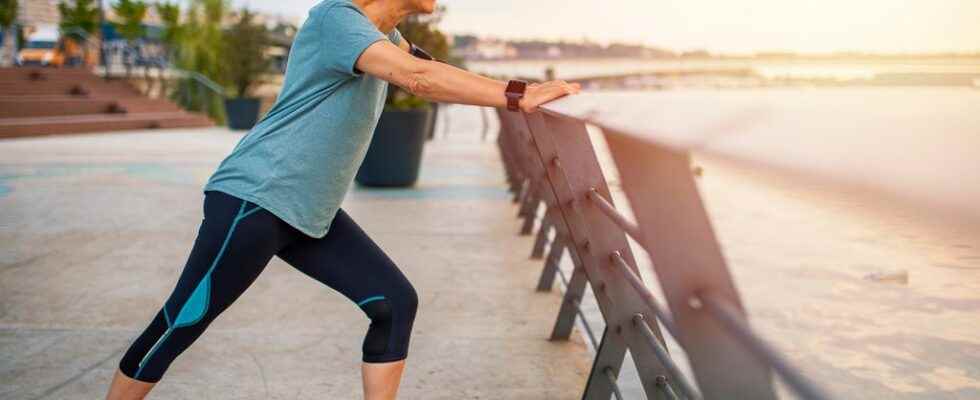[DIAPORAMA] It is a well-established fact: physical exercise helps to preserve the youth of the body. But putting movement at the heart of our daily lives also brings many other benefits. Find out which ones and then jump into brisk walking, planking and stretching.
“Exercising regularly helps to keep a firm, toned and flexible body, even beyond the age of 60,” assures Dr. Denys Barrault, president of the French Society for Exercise and Sport Medicine. “As activity levels tend to decrease from the age of 20-25, it is essential to integrate a suitable exercise program into your daily routine”, insists Barbara Bushman, American author of the Complete Guide to Fitness and Health.
To go in this direction, the two experts recommend combining four types of exercises to maintain different skills that atrophy over the years, especially if they are not exercised:
- cardio-training activities (good for the breath, heart and arteries)
- muscle building (to maintain muscles)
- flexibility exercises
- neuromotor activities (for balance, agility and coordination).
“If, during your thirties, it is possible to focus especially on the first two types of activities, from the age of 40, it is necessary to pay more attention to flexibility and neuromotor exercises”, explains Barbara. Bushman. Discover the exercises she recommends to keep a young body.
# 1 brisk walking or running
These two activities allow you to preserve your breath and your heart, but also the strength of the bones, and thus avoid the inconveniences associated with age: loss of mobility, cardiovascular diseases, etc. There are several alternatives: swimming, cycling, kayaking… These sports, where the weight of the body does not rest on the legs, are less traumatic for the joints. But they only stimulate part of the musculature (legs for cycling, upper body for kayaking, etc.).
>> In practice: walk at least 30 minutes a day, 5 days a week, or 150 minutes total per week. Or at least 20-25 minutes of running, three days per week, or a total of 75 minutes per week Or a combination of both, at least 20-30 minutes per day, 3 to 5 days per week. week.
# 2 the board
This exercise helps to strengthen the lower back and the abdominals (“lumbar-abdominal sheathing”). Enough to maintain a good posture – and thus prevent the sagging of the silhouette -, keep a flat stomach, but also avoid back pain, knowing that the back muscles stabilize the vertebrae.
>> In practice: get down on all fours with your back straight; then extend the right leg and the left arm at the same time. Hold for 20-30 seconds. Rest 30 seconds. Then repeat 3 times. Repeat with the other leg and the other arm. To be practiced every other day, so that the muscles have time to recover.
# 3 squats
They are excellent for combating the wasting of large muscles: the muscles of the thighs (quadriceps and hamstrings) and the glutes – which lose in volume and tone from the age of 20, while they are mobilized at the daily for walking, sitting, etc. This allows you to keep your thighs and buttocks shapely, but also to continue to perform certain everyday movements without difficulty (climbing the stairs, sitting down, squatting, etc.).
>> In practice: stand with your back straight, feet shoulder-width apart and toes slightly outward, bend your legs and step down, buttocks back, hips below knee level; then return to the initial position. Start with 2 sets of 10 squats, spaced 2-3 minutes of recovery, 1 to 2 times a week. Then gradually increase the frequency and number of sets and squats, up to 4 sets of 40 squats, 3 times a week. At the same time, go up the stairs instead of taking the elevator. And on tiptoe, to increase its effectiveness tenfold!
# 4 capsizing
This exercise stimulates motion detectors present in the joints, and strengthens balance. Which is also affected by aging, but also by muscle and ligament injuries, especially in case of immobilization or surgery. What to feel confident when walking and, with advancing age, to reduce the risk of falls, which are frequent among seniors.
>> In practice: Standing with head straight, feet hip-width apart and firmly planted on the floor, lift the right leg out to the side. Hold for as long as possible, but no more than 30 seconds. Rest the foot. Then lift the other leg. Repeat 5 times for each leg. For those “allergic” to any physical activity or those who run after time: brush your teeth on one leg. This allows you to work on your balance very regularly over short periods of time (3 minutes on average each time).
# Stretching
This type of exercise is essential to preserve your flexibility, which allows graceful movements, contributes to general well-being and makes possible a number of daily actions (bending over to tie your shoes, putting on a coat, etc.). However, age decreases the flexibility of the joints which contribute to this aptitude. In addition, the joints also atrophy if they are not used enough daily (sedentary lifestyle). Hence the need to exercise them.
>> In practice: lie on your back, arms and legs straight. While blowing, stretch from the feet to the fingertips, like a rubber band that is stretched. Hold for 10 seconds. Repeat 10 times. Ideally, do it every day, for example when you get up or before going to bed; or at least 2 or 3 times a week. You can vary the exercises, for example by stretching your legs one after the other, placing your hands on either side of the thighs.
Read also :
Subscribe to the Top Santé Newsletter to receive the latest news for free








